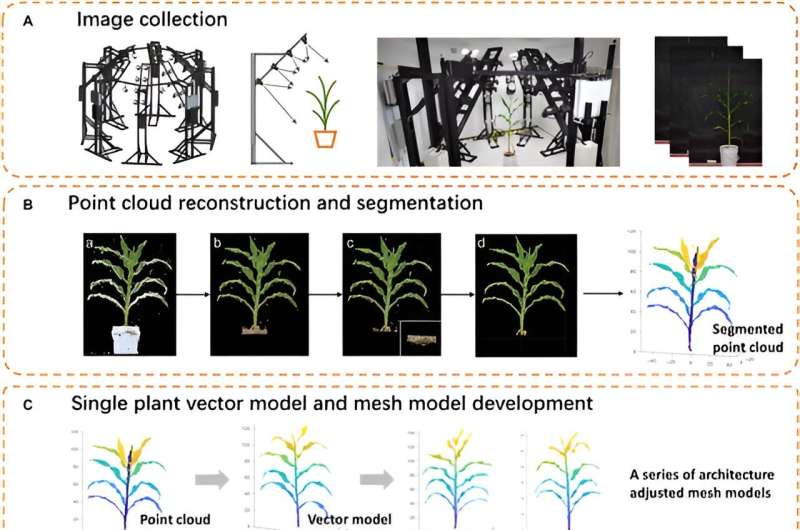This article has been reviewed according to Science X's editorial process and policies. Editors have highlighted the following attributes while ensuring the content's credibility:
fact-checked
trusted source
proofread
Novel 3D canopy modeling pipeline unravels key factors in maize photosynthesis

Boosting energy conversion at the canopy level is crucial for augmenting biomass and crop productivity, with factors like leaf photosynthesis efficiency, canopy architecture, and leaf chlorophyll content playing vital roles.
Despite advancements in genetic studies on leaf photosynthesis across crops, the complex interplay of these factors complicates the understanding of canopy photosynthesis. Computational models have aided in dissecting these complexities, but developing comprehensive 3D canopy models remains challenging.
In July 2023, Plant Phenomics published a research article titled "Quantifying Contributions of Different Factors to Canopy Photosynthesis in Two Maize varieties: Development of a Novel 3D Canopy Modeling Pipeline."
The study utilized a 3D canopy modeling pipeline to assess architectural and photosynthetic traits in two maize varieties, W64A and A619, at various growth stages. This involved generating point clouds of individual plants using a structure-from-motion and multi-view stereo (SFM-MVS) method with a 64-camera system (MVS64).
The precision of these point clouds was confirmed using LiDAR, demonstrating a median gap of 3mm between the MVS64 and LiDAR datasets.
Plant architectural traits derived from the point clouds correlated well with manually-measured data, indicating the method's precision. Significant differences in plant architecture were observed between the two maize lines. The leaf number of W64A was higher than A619 in later stages, though stem heights were similar. A619 exhibited longer leaves at maturity, with no significant difference in leaf width. Leaf chlorophyll content, measured via SPAD values, was lower in A619 in the initial stages.
Relationships between SPAD values, leaf transmittance, and reflectance were established, aiding in the calculation of these leaf properties.
The study also analyzed leaf photosynthesis rates, revealing that A619 had a higher photosynthetic rate in upper layer leaves under most light levels. However, the difference in the bottom layer leaves' photosynthesis was significant only at 38 days after sowing (DAS).
The research dissected the roles of diverse traits in canopy photosynthesis through 3D models, indicating that leaf photosynthesis exerted the most substantial influence on the overall CO2 uptake in canopy photosynthesis.
The research then explored how modifications in photosynthetic and architectural traits affected canopy photosynthesis in both maize varieties. Simulations indicated that changes in leaf photosynthetic light response parameters linearly correlated with total canopy photosynthesis, especially in the upper layers.
Adjustments in plant architectural parameters like leaf width, length, and number showed non-linear relationships with canopy photosynthesis. The study also identified optimal values for these traits at different growth stages.
Conclusively, the study highlighted that leaf photosynthesis was the primary factor influencing canopy photosynthesis, accounting for a 17.5% to 29.2% difference between the two varieties.
The impact of plant architecture was secondary, particularly in the early growth stages. The 3D canopy modeling process developed in this study not only clarifies the contributions of individual characteristics to canopy photosynthesis but also presents a novel strategy for improving crop yield through ideotype breeding.
More information: Qingfeng Song et al, Quantifying Contributions of Different Factors to Canopy Photosynthesis in 2 Maize Varieties: Development of a Novel 3D Canopy Modeling Pipeline, Plant Phenomics (2023). DOI: 10.34133/plantphenomics.0075
Provided by NanJing Agricultural University




















